|
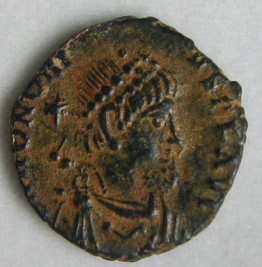
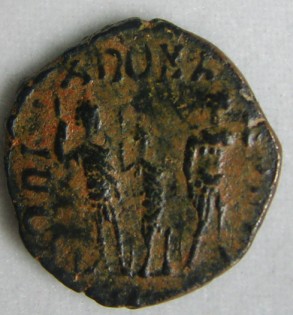 |
|
Honorius (Western Emperor)
395-423AD
Honorius AE4. Antioch mint, 406-408 AD. (14mm)
OBVS: DN HONORIVS P F AVG, pearl diademed,
draped bust right /
REV: GLORIA ROMANORVM, three emperors
standing side by side holding spears, outermost ones rest hands on
shields, the middle one holds an orb,
[ANTA] in ex.
RIC 153 (nice detailed bust and reverse, with
nearly full obverse inscription, and partial one on the reverse).
(CLICK FOR LARGE PICTURES) | |
|
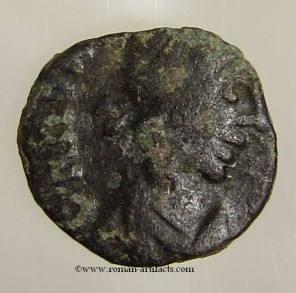
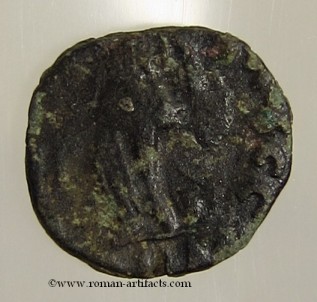
|
|
Honorius (Vandal Issue)
395-423AD
OBVS: DN HONORIVS P F AVG, pearl diademed,
draped bust right /
REV: VICTORI_A
AVGGG,Victory advancing left, wreath upward in right hand, palm in
left over shoulder
Mintmark: RM
Due to the crude bust and smaller size, this
coin is believed to be a un-official Vandal issue.
(CLICK FOR LARGE PICTURES) |
|
|
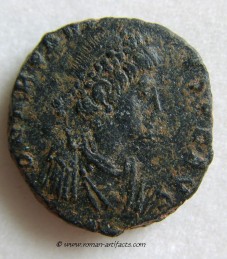
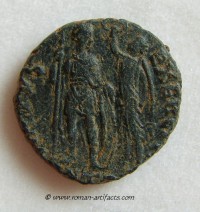 |
|
Arcadius (Eastern Emperor)
395-408AD
OBVS: D N ARCADI-VS P F AVG, pearl diademed,
draped, cuirassed bust right.
REV: VIRTVS-EXERCITI, emperor standing
left, head right, holding spear and resting left hand on shield.
Victory, standing beside him crowns him with a wreath held in her
right hand.
Mintmark ALEB. (Alexandria)
Amazing reverse detail, which is unusual for this
late period coin. The die maker was extremely talented,
something that faded in later years.
(CLICK FOR LARGE PICTURES) |
|
|
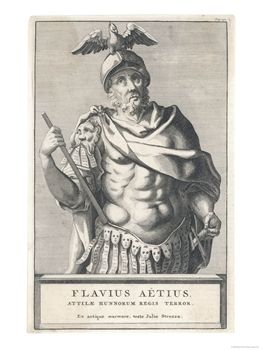 |
|
FLAVIUS
AETIUS 396-454 AD
"The last
true Roman" (a short bio)
Flavius Aetius or simply
Aetius, was a Roman general of the closing period of the Western
Roman Empire. Scholars often have called him "the man
universally celebrated as the terror of Barbarians" for this
continued victories over the barbarian invasions of that period and
especially against Attila the Hun at the Battle of Chalons (451 AD).
This battle although considered a stalemate was the first battle
that put a stop to Attila's rampage through Europe. Attilla
would never severely challenge the borders again and within 2 years
was himself dead.
In 423 AD Aetius supported
the new emperor Johannes who was praised for his mildness,
intelligence, and general ability. Unlike the Theodosian emperors,
he tolerated all Christian sects. Aetius however arrived 3
days late (with a Hun army) to save Johannes who had been betrayed
in Ravenna and killed by the army that Theodosius II (Eastern
Emperor) had sent. Valentinian III was then appointed emperor by
Theodosius I. Valentinians 25+ year rule was considered
incompetent and did nothing to save Rome from the barbarians.
The final blow came in 454 AD when Valentinian III assassinated Aetius
in Rome.
Sidonius Apollinaris is
credited with the famous observation,
"I am ignorant, sir, of your
motives or provocations; I only know that you have acted like a man
who has cut off his right hand with his left"
Rome would never recover and
in within the next 25 years the barbarians would crush the last
emperor, ending a thousand year empire in Europe. | |
|
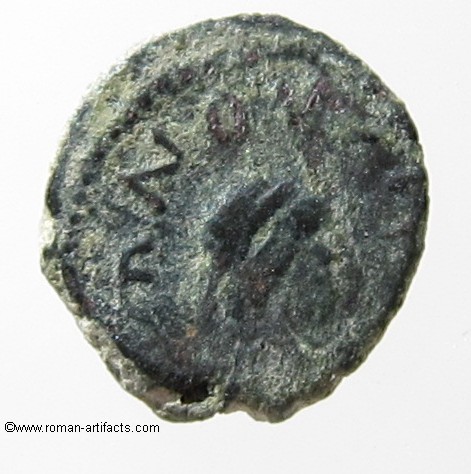
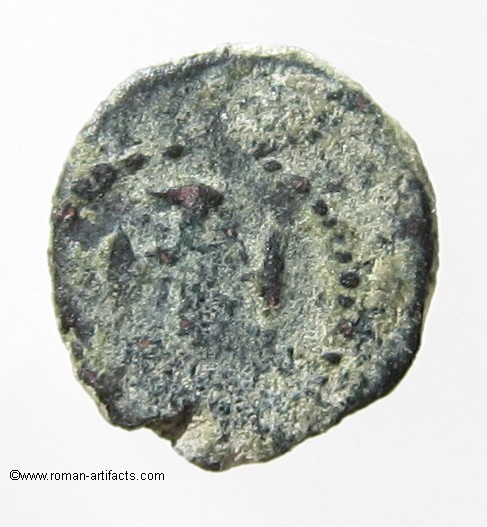 |
|
Bonifacius
Comes Africae, AD 422-431.
Æ 10mm
Carthage mint. Struck AD 423-425.
OBVS: [DO]MINO
NO[STRO], pearl-diademed, draped, and
cuirassed bust right
REV: Cross within wreath.
RIC X 3810
(very rare coin) This coin is attributed to Bonifacius.
A key, but fleeting figure in the later Roman period.
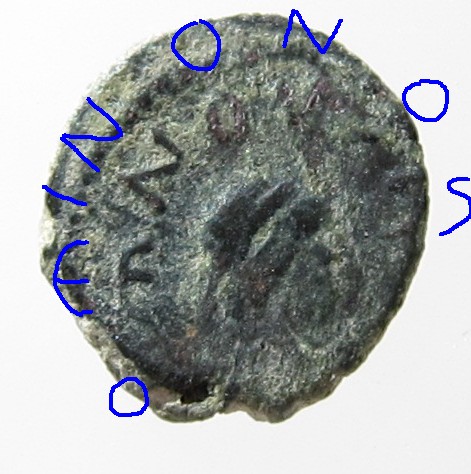
Comes Bonifacius (anglicized in
Count Boniface) (died 432) was a Roman general and governor of the
Diocese of Africa. Along with his rival, Flavius Aëtius, he is
sometimes termed "the last of the Romans."
After the death of Emperor Honorius in 423, primicerius notariorum
Joannes was elevated to the throne. Bonifacius refused to
acknowledge him, and prevented the plentiful shipments of African
grain from reaching Italia. After a revolt in Gaul, and an uprising
by general Aëtius, Joannes was overthrown, Valentinian III, nephew
of Honorius, was made Western emperor by the Eastern Roman Emperor,
Theodosius II. Bonifacius supported him, and resumed grain
shipments.
Under the influence of Aëtius, the emperor's mother Galla Placidia
convicted Bonifacius of treason against the emperor. Rather than
surrender to probable execution, however, Bonifacius called in the
support of Vandal mercenaries from their grazing grounds in
Hispania. The entire tribe migrated en masse into Africa. However,
by the time they arrived, Bonifacius had returned to Placidia's
favor, and she had granted him the title of Patricius. He informed
the Vandals that their services were no longer needed, but instead
of returning to Hispania, they revolted and drove the Roman Empire
out of Africa. The Vandals would rule the diocese until the Eastern
Romans under Flavius Belisarius recaptured it in 534.
Bonifacius had been recalled to Italy before the Vandals had seized
the province, elevated to the rank of magister militum praesentalis
and to the dignity of Patricius. Fearing an imminent dismissal,
Aëtius and his army of Germanic mercenaries marched against
Bonifacius, descending upon Italy; the result was the Battle of
Ravenna (432), which Bonifacius won, despite being mortally wounded.
He died several months later, being succeeded by his son-in-law
Sebastianus. However, the following year Aëtius would depose
Sebastianus and become the de facto ruler of the Western Roman
Empire.
| |
|
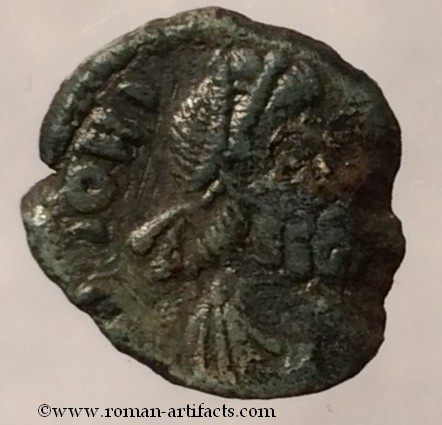
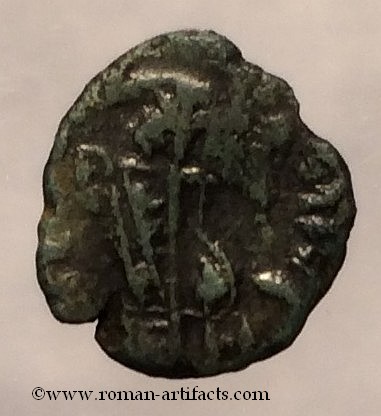
|
|
Johannes (Augustus)
Usurper 423-425 AD
AE4 (11mm)
OBVS: [D] N IOHA[NN-ES P F AVG], pearl-diademed, draped, and
cuirassed bearded bust right
REV:[SALVSREI-P]VBLICE, Victory advancing left, holding trophy
over right shoulder, dragging captive with left hand; Christogram to
left; P//RM
(Rome Mint).
RIC X 1916; Ulrich-Bansa 7b; LRBC 833
(CLICK FOR LARGE PICTURES) |
|
|
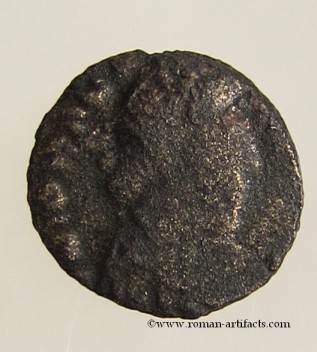
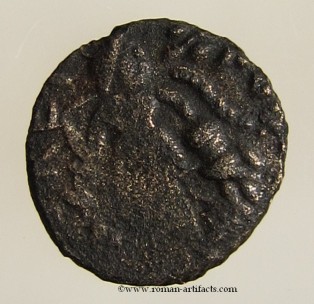
|
|
Johannes (Augustus)
Usurper 423-425 AD
AE4 (11mm)
OBVS: [D] N IOHANN-E[S P F AVG], pearl-diademed, draped, and
cuirassed bust right
REV:[SALVS] REI-[PVBL]ICE, Victory advancing left, holding trophy
over right shoulder, dragging captive with left hand; Christogram to
left; P//RM (Rome Mint).
RIC X 1916; Ulrich-Bansa 7b; LRBC 833
References: Nearly identical Obverse and reverse
die of Johannes on a coin sold by Ancient Coins Canada.
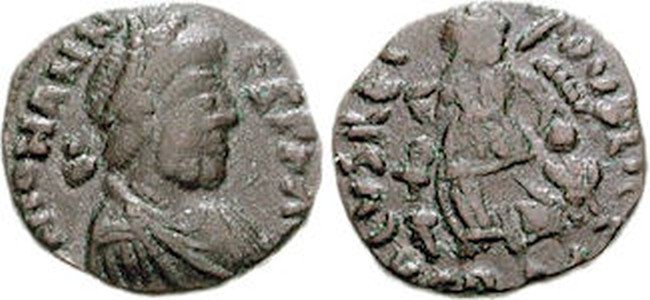
(CLICK FOR LARGE PICTURES) |
|
|
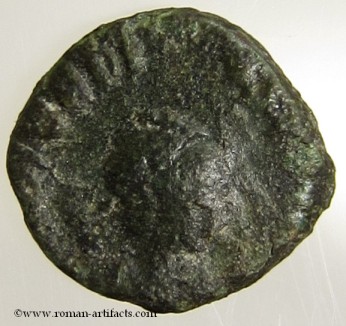
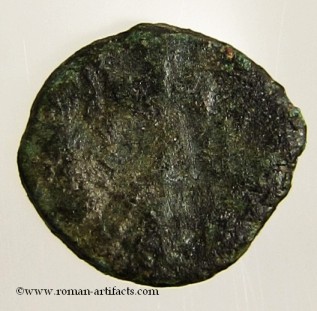
|
|
Valentinian III (Western Emperor)
425-452 AD
AE4 (10mm), 425-c.435,
OBVS: DN VALENTINIANO PF AVG, Pearl diademed, draped and cuirassed
bust right.
REV: No legend, Cross within wreath.
Mintmark SMKA.
References: RIC X, 452
(CLICK FOR LARGE PICTURES) | |
|
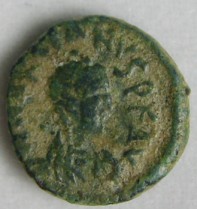
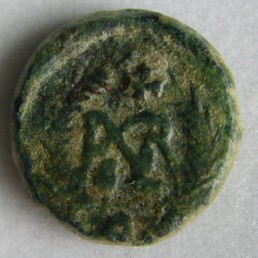 |
|
Marcian (Eastern Emperor)
450-457 AD
Marcian AE4. Constantinople mint. (10mm)
OBVS: D N MARCIANVS P F AVG, diademed, draped & cuirassed bust right
REV: Monogram of Marcian in wreath, + above, S below, CON in ex.
References: RIC 545 (rare in this state with nearly a full
inscription on the obverse, full wreath and partial mint visible)
(CLICK FOR LARGE PICTURES) |
|
|
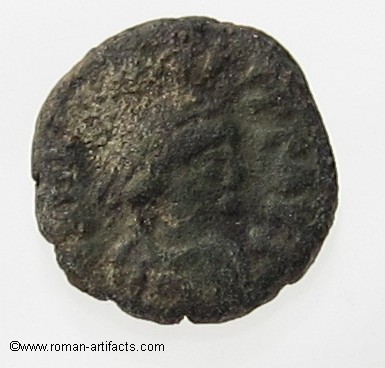
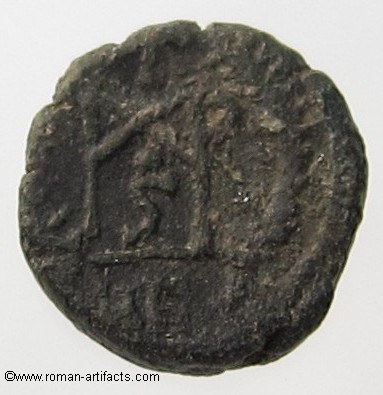 |
|
Marcian (Eastern Emperor)
450-457 AD
AE4. Constantinople mint. (11mm)
OBVS: D N MARCIANVS P F AVG, diademed,
draped & cuirassed bust right
REV: Monogram of Marcian in wreath, + above, S below, CON in ex
(monogram variety with pellet
above S not listed in RIC.)
References: RIC X -, SRCV 4327
(CLICK FOR LARGE PICTURES) | |
|
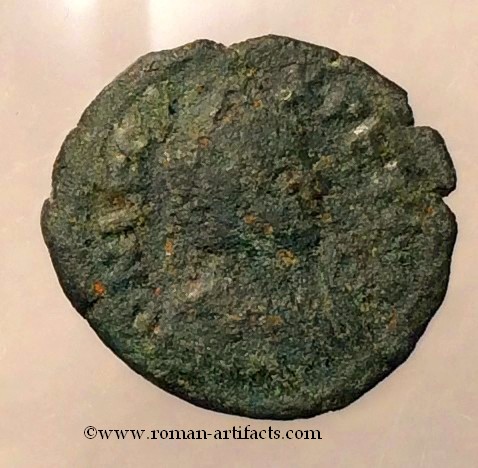
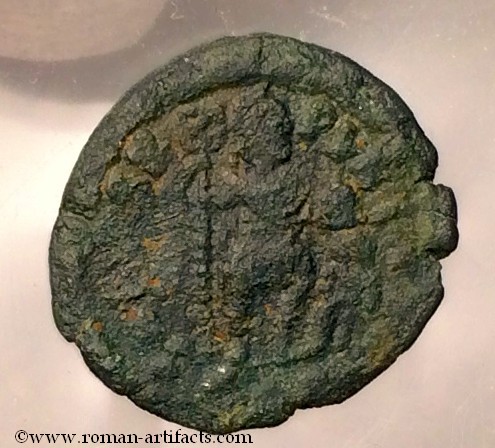 |
|
Leo I (Eastern Emperor)
457-474 AD
Bronze AE 20mm. Constantinople mint,
for use at Cherson.
OBVS: DN LEO PE RPET AVG, diademed,
draped & cuirassed bust right /
REV: SALVS R-PVBLICA (sic), Leo
standing right, holding labarum & globe, spurning bound captive;
CON. Rare and large coin RIC 657
(CLICK FOR LARGE PICTURES) |
|
|
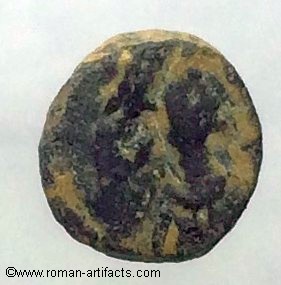
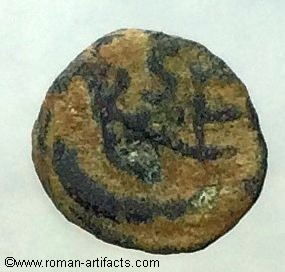
|
|
Leo I (Eastern Emperor)
457-474 AD
Bronze AE2 10mm.
OBVS: D N LEO P F AVGO, diademed,
draped & cuirassed bust right /
REV: Monogram 1b variant within wreath.
Mintmark off flan Constantinople mint Rare coin RIC
676 |
|
|
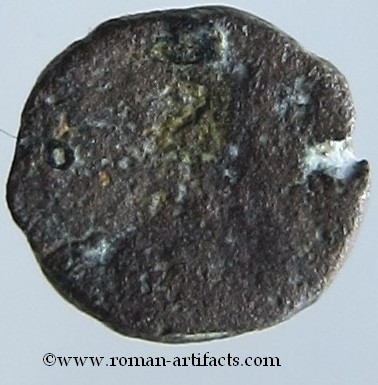
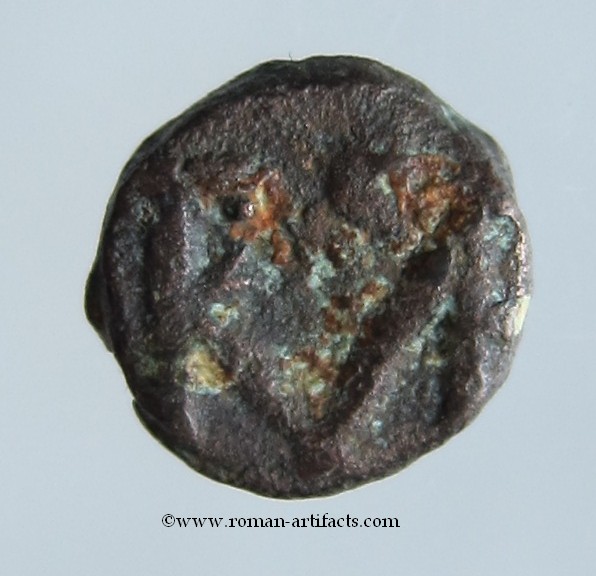
|
|
Libius Severus III (Western Emperor)
461-465 AD
AE4 9mm.
Rome mint
OBVS: Diademed, draped & cuirassed bust right
REV: Monogram of Ricimer.
Reference: RIC 2716 & LRBC 871
Rare coin for a short lived late Roman Emperor.
(CLICK FOR LARGE PICTURES) |
|
|
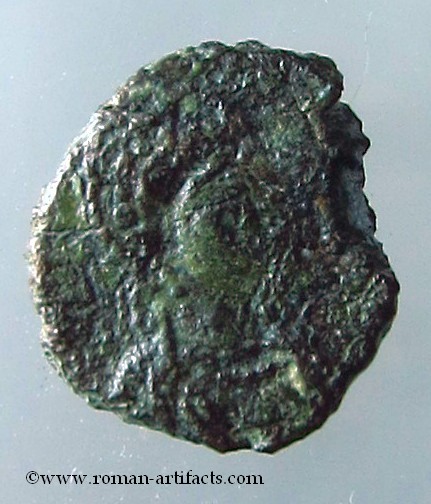
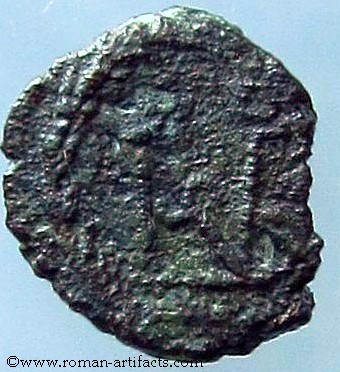 |
|
Aelis Zenonis (Eastern Usurper)
476-477 AD
AE4. 11mm 0.9g
OBVS: Diademed and draped bust right
REV: Zenonis monogram within wreath.
References: RIC X 1018.
Aelia Zenonis was the wife of Basiliscus, who briefly usurped the
throne from the Emperor Zeno in the critical year of 475/476 AD.
The turmoil in the Eastern Empire allowed the Germanic chieftain
Odovacer to depose the last Western Roman Emperor, Romulus
Augustus, thus ending the West Roman Empire
Very rare coin, even in this state.
(CLICK FOR LARGE PICTURES) |
|
|
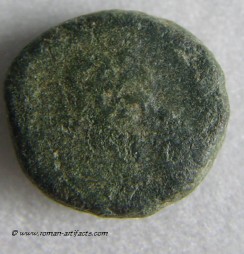
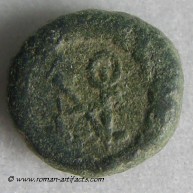 |
|
Zeno (Emperor whole empire until 476 AD when
Odovacar took over)
474-491 AD
Nummus. Constantinople mint, second reign.
OBVS: Pearl-diademed, draped bust right
REV: Monogram
of Zeno.
(CLICK FOR LARGE PICTURES) |
|
|
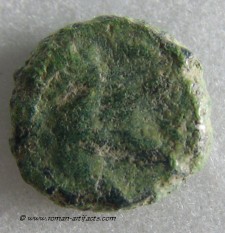
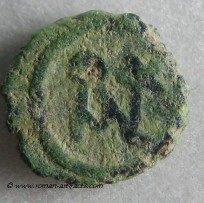 |
|
Anastasius I (Eastern
Emperor)
491-518 AD AE4 Nummus.
Constantinople mint. OBVS: Diademed
bust right REV: Monogram of Anastasius
within linear circle. References: SEAR 13 &
DOC I 15.
(CLICK FOR LARGE PICTURES) | |
|
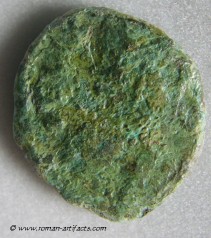
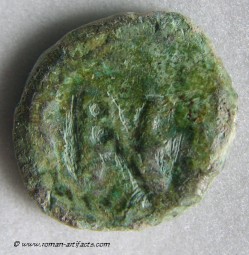 |
|
Theodoric The Great (Ostrogoth Italian King)
493AD - 526 AD
(respected roman way of life/laws, and held a
strong relationship with eastern empire, under Justinian I)
Theodoric Information(click)
AE 10 Nummi
Struck circa 493-518 AD, Ravenna mint.
OBVS: Crowned and draped bust
of Ravenna right
REV: Monogram of Ravenna within wreath.
References: Metlich 78a; MIB I 72a (Municipal
Issue of Ravenna); MEC 1, 145
(CLICK FOR LARGE PICTURES) |
|
|
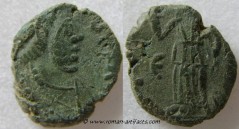
|
|
Johannes (Vandal Issue)
Usurper 423-425 AD
AE4 (10mm)
OBVS: DNIOHANNESPFAVG - Diademed, draped
and cuirassed bust right. With distinctive beard
of Johannes.
REV: VICTORIAAVGG - Victory advancing
left, holding wreath and palm. Exergue: RM
& E (epsilon) in left field
Mint: Rome
References: Believed to be a Vandal issue, due to
the unusual reverse victory shape and the slightly different bust.
The face however clearly is bearded and the features otherwise fit
the above official mint.
(CLICK FOR LARGE PICTURES) |
|
|
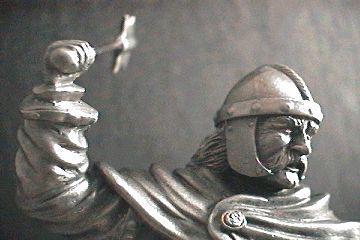 |
|
Gothic Wars 535 -554 AD
The Gothic War was a war fought in Italy and
the adjoining regions from 535 AD until 554 AD between the army of
the Eastern Roman Empire (Byzantine) and the tribes under the
control of the Ostrogothic Kingdom of Italy (which began after
Odovacar deposed the last Western Emperor in 476 AD). It is commonly
divided in two phases, the first (535-540) which ended with the fall
of Ravenna and the apparent conquest of Italy by the Romans, and the
second phase (540/541-553), where the Gothic resistance was
reinvigorated under Totila (Baduila) and was surpressed only after a
long war by the General Narses, who also defeated the Frankish-Alamannic
invasion of 554 AD.
The war had its roots in the ambition of Roman
Emperor Justinian to recover the provinces of the former Western
Roman Empire, which had been lost to invading barbarian tribes
during the previous century. The long duration of the conflict
meant that in the end Italy was devastated and depopulated with the
Italian population dropping from 7 millions to 2.5 millions as a
consequence of war, famine and epidemics. The Eastern Empire's
resources were depleted and as such the East Romans were unable to
resist the invasion of the Lombards in 568, which led to the loss of
large parts of the Italian peninsula.
Read more
here
|
|
|
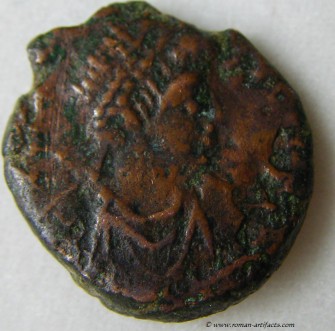
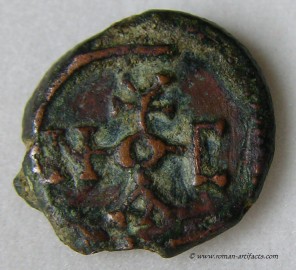 |
|
Justinian I
Easter Roman Emperor
527-565 AD Pentanummium 13mm
Antioch mint. OBVS: Diademed, draped
and cuirassed bust right. REV: Monogram
number 2 of Justinian I
within linear circle. Justinian I began the re-conquest of large
parts of Africa and Italy that had previously been lost to the
Vandals and Ostrogoths. For a short period of time the Roman
Empire was nearly whole again.
(CLICK FOR LARGE PICTURES) | |
|
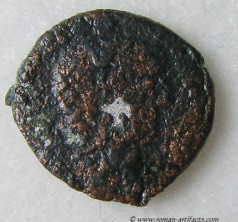
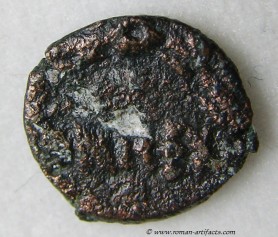
|
|
Last Ostrogothic King of
Italy Baduila
541 -552 AD
9mm
OBVS: Bust of Baduila facing right
REV: DN REX with line above DN and B underneath (not visible).
Surrounded by wreath.
(CLICK FOR LARGE PICTURES) |
|
|
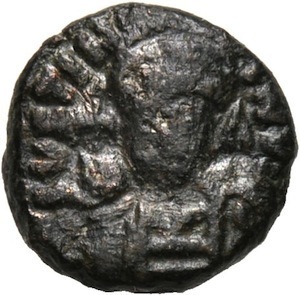
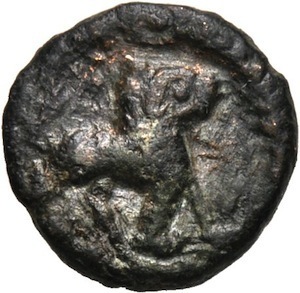 |
|
Justinian I
Easter Roman Emperor
527-565 AD 9mm
Nummus, 0.8g. (h).
Rome mint , c. 547 AD. (after its capture by
Belisarius)
OBVS: [DN] IVSTIN IANV [S] Helmeted, cuirassed bust
front holding globus cruciger and shield.
REV: Lion standing right within wreath.
References:
Berk 289. MIBE 232.
This type with a lion on the reverse may have been introduced by
the famous Roman/Byzantine general Belisarius in connection with the
ludi saeculares of the city (Rome) in 547; the 1300th anniversary of
Rome's foundation.
A very rare coin, with a short minting period and an important
historical point. Its connection to one of the greatest late
Roman generals also make it further interesting. |
|
|
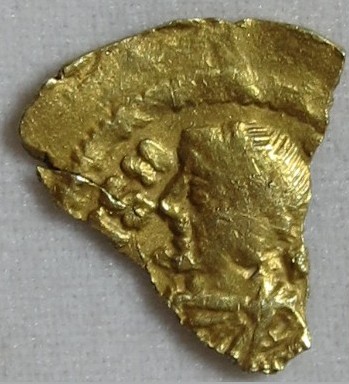
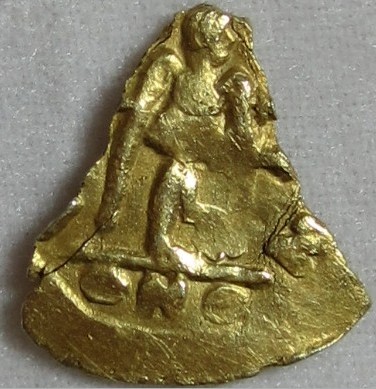
|
|
Justin II Imitation
Easter Roman Emperor
565-578 AD Gold Tremissis (Fragment).
0.6 gr. Constantinople.
OBVS: DN IVSTI NVS PP AVI, pearl diademed,
draped, cuirassed bust right REV: VICTORIA
AVGVSTORVM Victory advancing right, head left, holding wreath
and cross on globe; star in right field; mintmark [C]ONO [B].
References: DO 13-14; SB 353.
Due to the left facing bust, and the C and B missing, it is likely
that the this coin is some type of barbaric imitation from the
period. Large areas of Italy, Spain and other areas which had
been captured previously by Justinian I were lost. It is
likely that this coin was struck during this period of decline in
one of these areas. | |
|
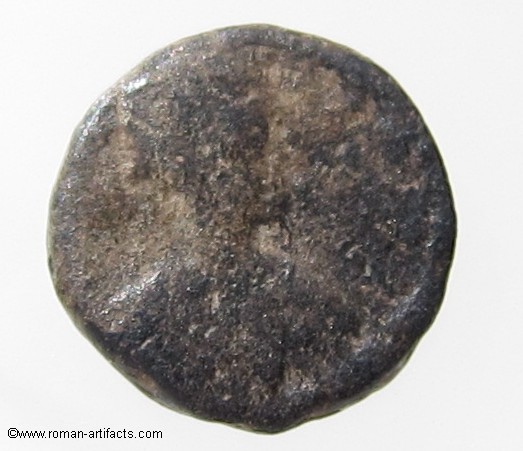
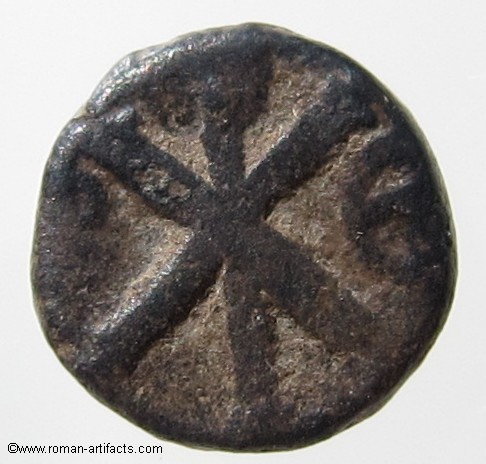
|
|
Justinian I
Easter Roman Emperor
527-565 AD
Bronze pentanummium, SBCV 169, DOC I 35, Fair,
Constantinople (Istanbul, Turkey) mint, weight 1.31g, maximum
diameter 11.3mm,
OBVS: D N IVSTINIANVS P P AVG (or similar), diademed,
draped and cuirassed bust right;
REV: large chi rho Christogram, uncertain letter left
(officina), E right;
|
|
|
|
|
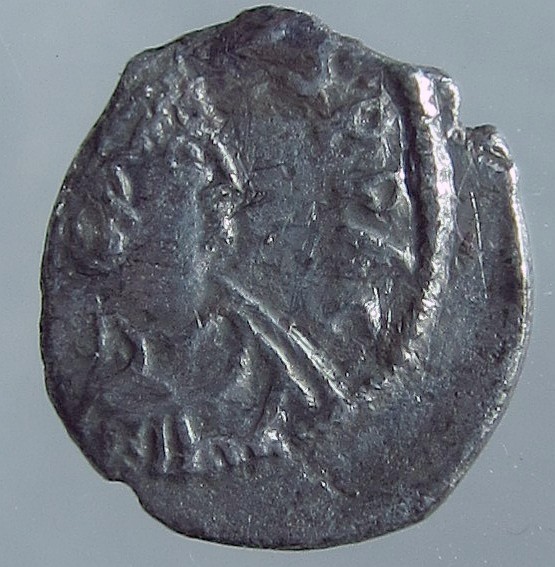
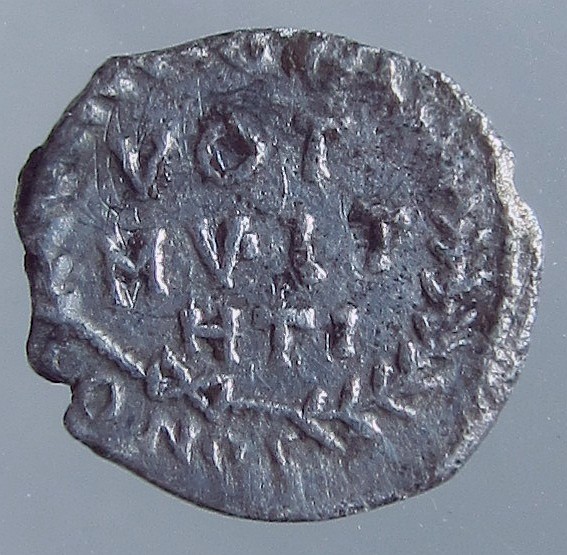
|
|
Justinian I
Easter Roman Emperor
527-565 AD Silver Siliqua 1.2 gr
Carthage mint 534 AD.
OBVS: DN IVSTI NVS PP AC, pearl diademed,
draped, cuirassed bust right REV: VOT MVLT
HTI in wreath CONOS
References: DOC 280 Sear 280 | |
|
